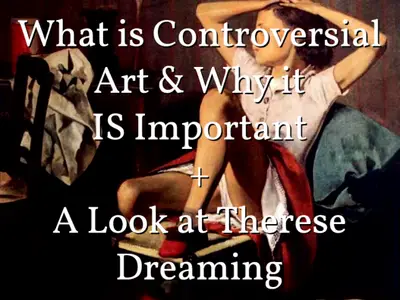What is Controversial Art & What is the Point in it?

Generally speaking, the purpose of controversial art is to elicit the greatest amount of emotion from viewers. Particularly certain artists have gone to considerable efforts to do this in their works and are said to have contributed to the rise of the debate over what constitutes appropriate by traditional artistic standards.
When certain artworks were first presented to society, they were met with backlash that included public destruction and censorship, which only served to boost the appeal of the pieces. No of the era, there have always been painters who dared to defy the accepted customs and depict subjects that were widely regarded as taboo and, in essence, banned.
Important discussions about the freedom of creativity and expression of artists have been promoted because these works of art are typically derided in public and frequently prohibited.
Art has long been used to convey messages that cut beyond linguistic boundaries since it is known to have purposes beyond just aesthetic appeal. Provocative artworks in particular have provided the much-needed spark to start necessary dialogues on particular subjects.
Even if viewers do not agree with the sentiments expressed, the opinions gleaned from these pieces of art provide insight into the opposing viewpoint. Since these works of art are a reflection of the thinking of the artists and society, it may be said that controversial art enables us to examine ourselves and assess the veracity of our own convictions.
We are no longer surprised by the appearance of divisive artwork in the twenty-first century. Provocative art eventually emerged as a result of the development of other startling art movements, such as Dadaism, Cubism, Fauvism, and Modern Art, as well as numerous political and societal upheavals.

This is still the case today. For millennia, artists have poured their hearts into their creations, creating amazing (or occasionally terrible) compositions that leave the audience speechless. However, art serves purposes beyond those that are purely aesthetic.
It is an effective means of communication since it served as a platform for human expression even before people could read or write. For millennia, artists have poured their hearts into their creations, creating amazing (or occasionally terrible) compositions that leave the audience speechless. However, art serves purposes beyond those that are purely aesthetic.
It is an effective method of communication; its influence became apparent even before people could read or write. Art has long been used to convey ideas that cut beyond linguistic boundaries and has frequently served as a catalyst for important discussions about the world we live in.
However, using art to communicate has its drawbacks. The message of art can often cause discomfort and shock in people, who therefore demand that it be put away or destroyed. Méret Oppenheim’s 1936 assemblage sculpture “La Déjeuner en fourrure,” which some found to be scandalous and sexual, caused a woman to pass out when it was initially displayed in Paris. “Thérèse Dreaming,” a work by Balthus, is a more recent illustration of art’s contentious nature.
New Yorker Mia Murrell, then 30 years old, was inspired to launch a petition after seeing the picture at the Metropolitan Museum of Art. Given the current context around sexual assault, she claimed, “The Met is romanticising voyeurism and the objectification of children” in a statement condemning the painting.
The Met, despite the petition’s widespread support, has refused to remove “Thérèse Dreaming,” arguing that the picture is representative of various eras and not just our own. According to Ken Weine, the Met’s chief communications officer, the museum’s goal is to “connect people to creativity, knowledge, and ideas” through its “collection, research, conservation, and presentation of great works of art throughout all time and culture.”
“In times like these, dialogue may flourish, and visual art is one of the most important tools we have for considering the past and the present, and for fostering the ongoing development of existing culture via thoughtful debate and appreciation of the arts.” One can see the tension between the public and the artist in this recent case.
The works of Balthus have a similar effect. You owe it to art, as Judith Thurman of the New Yorker puts it: “to study the complexities of your discomfort.” It’s in that area that his brilliance really shines. There is more to a work of art than meets the eye.
Art allows us to examine our own beliefs and determine whether or not they are valid, even if the audience doesn’t share our own opinions. It allows us to examine not only the artist but also their culture and, ultimately, ourselves.
An original viewpoint is always represented in a painting, regardless of whether or not the viewer agrees with that viewpoint. The naked woman and her threatening stare frightened viewers of Édouard Manet’s “Olympia” in 1885, prompting calls for the work’s destruction from critics and ordinary citizens alike.
The artwork is now shown at the Musée d’Orsay in Paris, where it has been acclaimed as a masterpiece. It is wrong to suppress creative expression because it upsets some people. Perhaps the most significant pieces of art are those that cause the most controversy. “Controversy is part of the nature of art and creativity,” Yoko Ono famously observed. Artists don’t do it; artesans do.

























